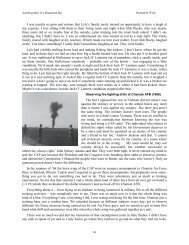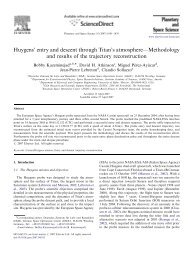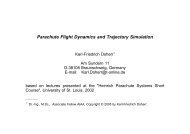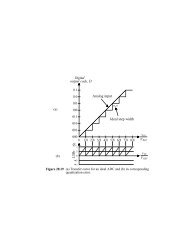THERMAL DESIGN AND PERFORMANCE OF PROBES IN THICK ...
THERMAL DESIGN AND PERFORMANCE OF PROBES IN THICK ...
THERMAL DESIGN AND PERFORMANCE OF PROBES IN THICK ...
Create successful ePaper yourself
Turn your PDF publications into a flip-book with our unique Google optimized e-Paper software.
The overall design of the Pioneer Venus probes is<br />
described in [1] and [2]. The thermal design of the<br />
large probe is discussed in some detail in [3].<br />
In brief, the interior of the large probe pressure<br />
vessel was lined with 41 layers of aluminized<br />
Kapton MLI to act as a barrier to radiation and<br />
convection. Structural penetrations of the blanket<br />
were made with Titanium to minimize conductive<br />
shorts. These features increased ‘R’. The ‘C’ term<br />
in the equation was maximized by using beryllium<br />
for the equipment shelves. This metal, although<br />
difficult to work with, has a heat capacity of some<br />
2000 J/kgK – double that of Aluminium.<br />
The MLI performance was tested with a nitrogen<br />
atmosphere, and with nitrogen+helium (since one<br />
of the experiments vented helium into the probe<br />
during descent.) This allowed the analytical<br />
thermal model to be updated, since the<br />
conductivity of helium is much higher than<br />
nitrogen by a known factor. Other tests showed<br />
free convection heat transfer coefficients for<br />
internal surfaces of 0.5 to 2 BT/hr-ft2-F<br />
The destructive effects of physical simulation to<br />
the full 900F made it necessary to limit tests to<br />
500F : when that temperature was reached the test<br />
was prolonged to permit internal temperatures to<br />
rise to the levels expected during the real descent.<br />
A thermal test model (TTM) was used for initial<br />
design verification. Note that because of the<br />
thermal sealing, electrical tests of the probe were<br />
limited to less than 2 hours [2] except when special<br />
cold nitrogen cooling was used.<br />
During a descent test on the flight unit, some of the<br />
internal heat transfer was found to be lower than<br />
the TTM or analysis suggested. One factor was<br />
believed to be the role of the cable harness in<br />
impeding gas flow [3].<br />
Flight temperature data and the predictions are<br />
shown in figure 1. Data – previously unpublished –<br />
are taken from [4]. Plots are referred to time of<br />
first loss of signal – data were sent prior to the<br />
short entry phase, during which time the plasma<br />
sheath caused a radio blackout. This forms the time<br />
reference.<br />
The three small probes clearly had a higher<br />
area:volume ratio. Accordingly, they needed<br />
thicker thermal blankets (61 layers). On both large<br />
and small probes the MLI blankets were held in<br />
place against the high entry g-loads by Titanium<br />
retainers. A second measure to decrease the<br />
internal heat transfer was the substitution of Xenon<br />
for nitrogen as the fill gas.<br />
Figure 1. PV large probe temperature history for<br />
the forward and aft shelves. Solid line are actuals –<br />
dashed are predictions. The probe started off<br />
slightly warmer than predicted (see Huygens later)<br />
but the temperature rise was slightly lower than<br />
expected.<br />
Xenon, with a high relative molecular mass, has a<br />
low thermal conductivity. (Its breakdown potential<br />
is quite low, which would be problematic for the<br />
high voltages associated with the large probe’s<br />
neutral mass spectrometer : the large probe retained<br />
nitrogen as the fill gas.)<br />
Figure 2. Small probe 2 (day probe) temperature<br />
history – the probe failed an hour after impact,<br />
with temperatures at 115 and 70C.<br />
The pressure inside all of the probes increased<br />
during their missions. The temperature rise of the<br />
gas, were it at the shelf temperature, would account<br />
for an ideal-gas pressure rise of only ~10-25%. The<br />
increase of ~50% implies the gas itself was<br />
considerably hotter than the shelf (as expected)<br />
although possible outgassing from materials (e.g.<br />
mylar may lose ~2% by mass as water) or small<br />
leaks may have also been a factor.









